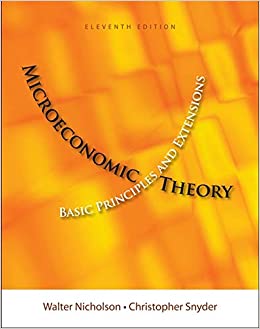
Microeconomic Theory 11th Edition by Walter Nicholson,Christopher Snyder
Edition 11ISBN: 978-1111525538
Microeconomic Theory 11th Edition by Walter Nicholson,Christopher Snyder
Edition 11ISBN: 978-1111525538 Exercise 1
An individual has a fixed wealth (W) to allocate between consumption in two periods ( c 1 and c 2 ). The individual's utility function is given by
 and the budget constraint is
and the budget constraint is

where r is the one-period interest rate.
a. Show that, in order to maximize utility given this budget constraint, the individual should choose c 1 and c 2 such that the MRS (of c 1 for c 2 ) is equal to 1 + r.
b. Show that
 is negative, what can you conclude about the price elasticity of demand for c 2 ?
is negative, what can you conclude about the price elasticity of demand for c 2 ?
c. How would your conclusions from part (b) be amended if the individual received income in each period ( y 1 and y 2 ) such that the budget constraint is given by

 and the budget constraint is
and the budget constraint is
where r is the one-period interest rate.
a. Show that, in order to maximize utility given this budget constraint, the individual should choose c 1 and c 2 such that the MRS (of c 1 for c 2 ) is equal to 1 + r.
b. Show that
 is negative, what can you conclude about the price elasticity of demand for c 2 ?
is negative, what can you conclude about the price elasticity of demand for c 2 ?c. How would your conclusions from part (b) be amended if the individual received income in each period ( y 1 and y 2 ) such that the budget constraint is given by

Explanation
a) The utility function is
The budget ...
Microeconomic Theory 11th Edition by Walter Nicholson,Christopher Snyder
Why don’t you like this exercise?
Other Minimum 8 character and maximum 255 character
Character 255


